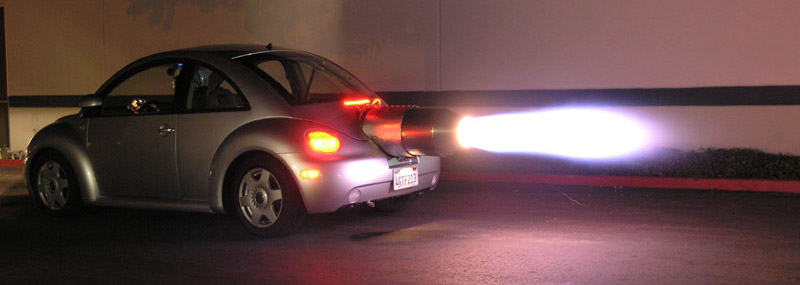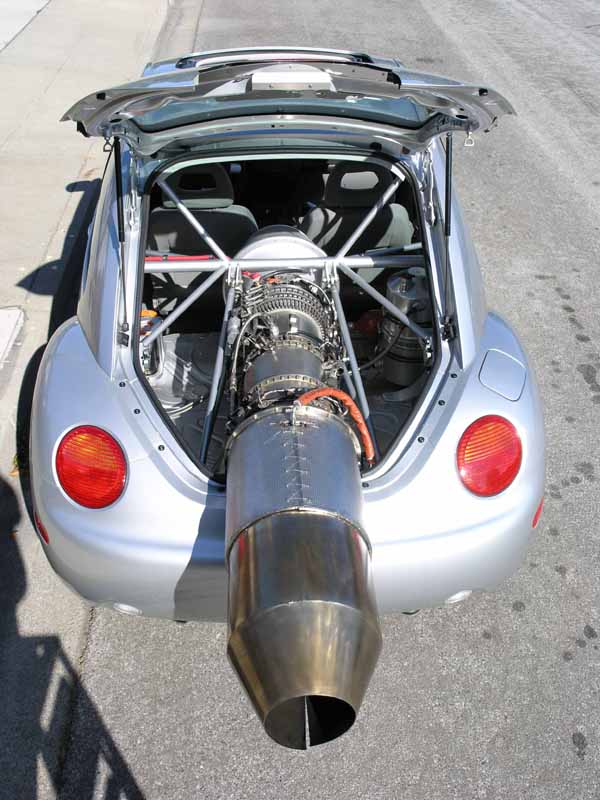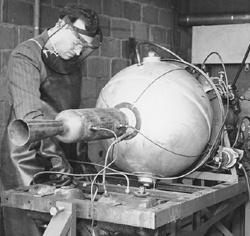Jet Assisted
Take-Off
1995 Darwin Awards Winner
Confirmed Bogus by Darwin
Confirmed Bogus by Darwin
 URBAN LEGEND! The Arizona Highway Patrol
were mystified when they came upon a pile of smoldering wreckage
embedded in the side of a cliff rising above the road at the apex of
a curve. The metal debris resembled the site of an airplane crash,
but it turned out to be the vaporized remains of an automobile. The
make of the vehicle was unidentifiable at the scene.
URBAN LEGEND! The Arizona Highway Patrol
were mystified when they came upon a pile of smoldering wreckage
embedded in the side of a cliff rising above the road at the apex of
a curve. The metal debris resembled the site of an airplane crash,
but it turned out to be the vaporized remains of an automobile. The
make of the vehicle was unidentifiable at the scene.
The folks in the lab finally figured out what it was, and pieced together the events that led up to its demise.
It seems that a former Air Force sergeant had somehow got hold of a JATO (Jet Assisted Take-Off) unit. JATO units are solid fuel rockets used to give heavy military transport airplanes an extra push for take-off from short airfields.
Dried desert lakebeds are the location of choice for breaking the world ground vehicle speed record. The sergeant took the JATO unit into the Arizona desert and found a long, straight stretch of road. He attached the JATO unit to his car, jumped in, accelerated to a high speed, and fired off the rocket.
The facts, as best as could be determined, are as follows:
The operator was driving a 1967 Chevy Impala. He ignited the JATO unit approximately 3.9 miles from the crash site. This was established by the location of a prominently scorched and melted strip of asphalt. The vehicle quickly reached a speed of between 250 and 300 mph and continued at that speed, under full power, for an additional 20-25 seconds. The soon-to-be pilot experienced G-forces usually reserved for dog-fighting F-14 jocks under full afterburners.
The Chevy remained on the straight highway for approximately 2.6 miles (15-20 seconds) before the driver applied the brakes, completely melting them, blowing the tires, and leaving thick rubber marks on the road surface. The vehicle then became airborne for an additional 1.3 miles, impacted the cliff face at a height of 125 feet, and left a blackened crater 3 feet deep in the rock.
Most of the driver's remains were not recovered; however, small fragments of bone, teeth, and hair were extracted from the crater, and fingernail and bone shards were removed from a piece of debris believed to be a portion of the steering wheel.
Ironically a still-legible bumper sticker was found,
reading
"How do you like my driving? Dial
1-800-EAT-SHIT."
www.DarwinAwards.com
© 1994 - 2007
Submitted by: Paul Kamrath
|
This Darwin Award is the most popular of all time. Considered true for years, it was later debunked as an Urban Legend by the Arizona Department of Public Safety. The story fooled the judges in 1995, and JATO has been grandfathered in as a Darwin Award Winner. Officer Bob Stein of the Arizona Department of Public Safety receives "inquiries several times a day about accidents, drug busts, investigations we are conducting. Two years ago, I picked up the phone and researched the answer to what has become an Arizona myth. Even after all this time, I still receive about five calls a month from people wanting to know, did it really happen?" Wikipedia on the JATO Rocket Car Urban Legend; That Great "The Real Rocket Car" Story!; Wired on the JATO story..
Orphiucus says: "This reminds me of a colleague's reminiscence, which may be the basis of the JATO story. He was a military pilot In the 50's in Guam, when two men strapped not one but two JATO engines to the back of a military Jeep. They took it to Guam's 3-mile airstrip and ignited the engines, which hurled them 200 yards down the runway before the Jeep, now travelling at more than 300 mph, disintegrated. The men were shredded to bits, and the engines broke free from the remains of the jeep and darted wildly around the base before burning out. A film of this incident exists, in a military archive or maybe in a shoebox in someone's attic. "
Scott McClave says: "Andy Granitelli ran the legendary STP Indy car racing teams of the 60's and 70's. This tale is from his book, They Call Me Mister 500. Granitelli had experimented with strapping a JATO rocket to a car back in the late 40's. They first tried just one JATO rocket attached to an open-wheel hot rod, with little success. (Later they discovered that the first rocket was a dud.) Thinking they needed more power, they tied multiple JATO rockets to a single start button. Fortunately for Granetelli, only one rocket fired, which still propelled the car well over 150 mph. That was enough to convince him to stop experimenting with JATO rockets. Why did Grantelli survive to tell the story? Because the JATO of the 40's was first-generation, designed to lift a single-engine Navy bomber off the deck of an aircraft carrier. The JATO rocket of today has significantly more thrust, and is typically used to lift a large four-engine C-130 transport off a short, primitive runway. A car just can't keep the modern rocket on the ground."
|
|
|







